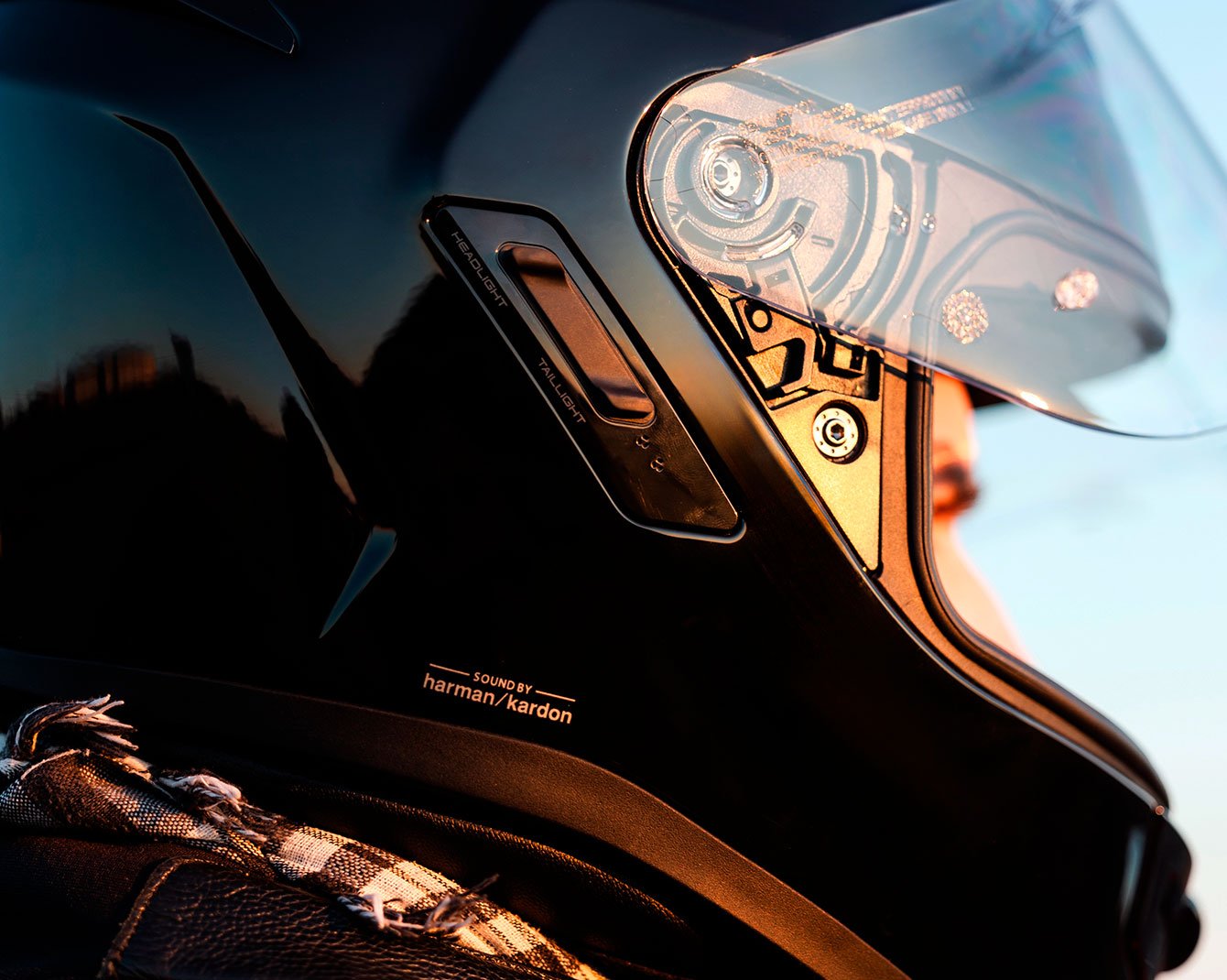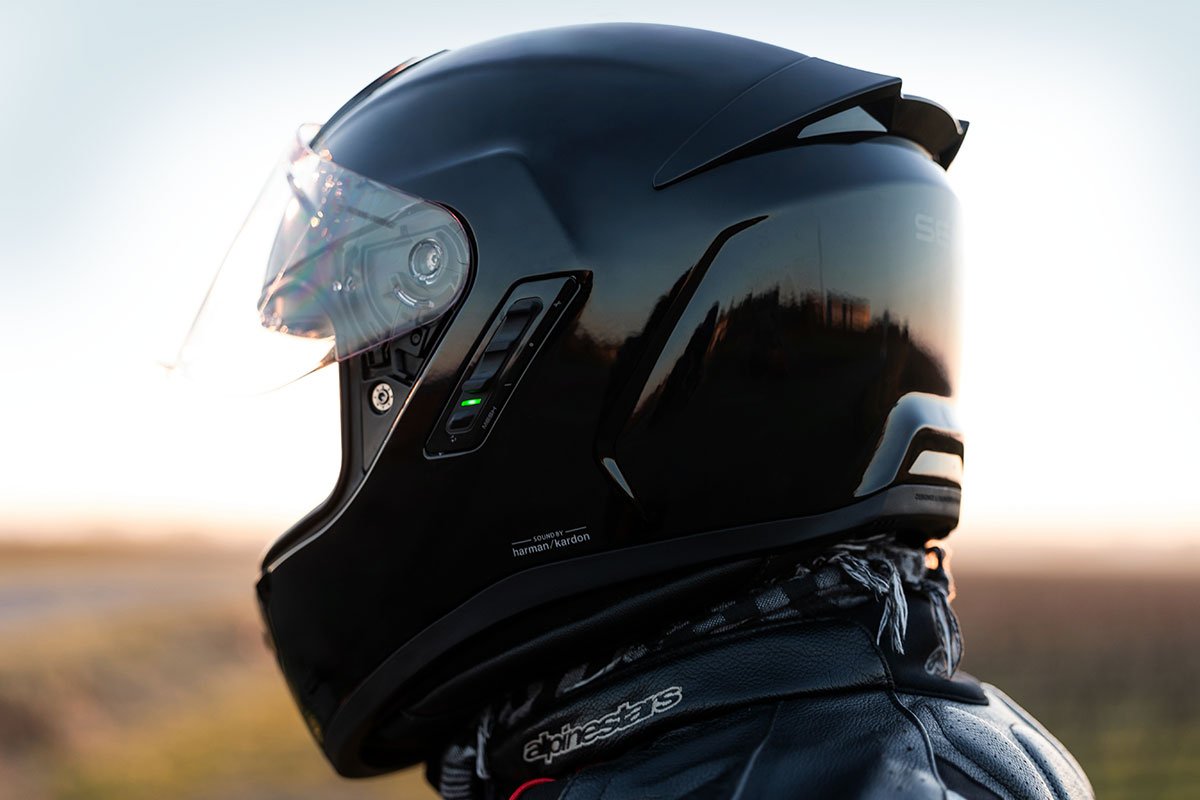The Sena Phantom emerges as a purpose-built smart helmet, consolidating communication and illumination into a single, cohesive unit. With a composite fiberglass shell meeting both DOT and ECE 22.06 certifications, the Phantom enters a competitive field of high-end touring and sport-touring helmets. Its core proposition is the seamless integration of Sena’s flagship 60S-derived technology, including Mesh 3.0 intercom and second-generation Harman Kardon audio, directly into the helmet’s architecture. This approach eliminates the aerodynamic and aesthetic compromises of bolt-on communication units. However, this integration brings its own set of considerations regarding performance, user interface, and long-term value when measured against established modular systems.
Design and Integration Analysis
The Phantom’s primary structural characteristic is its unified design. The composite fiberglass shell houses all electronic components—battery, processors, dual internal antennas, and speakers—within its form. This allows for an optimized internal layout, with specially designed acoustic chambers for the Harman Kardon speakers and a larger battery capacity than many external communicators. The result is a streamlined profile with flush-mounted controls, intended to reduce wind noise and improve aerodynamic stability. The helmet weighs a reported 1690 grams (±50g for a medium size), a figure that includes all integrated systems.
A key integrated feature is the illumination system. This consists of a front-facing LED “flashlight” on the chin bar and rear-facing LEDs that function as both running and brake lights, the latter activated by an onboard accelerometer. While the concept of integrated lighting is not new, its execution and effectiveness require scrutiny. Quantitative data on the lumen output of these lights is not readily available from the manufacturer, making direct comparisons to high-quality aftermarket lighting solutions difficult. The utility of the front-facing light is primarily for low-speed or stationary situations, such as map reading or maintenance checks.

Communication and Audio Sub-Systems
At the heart of the Phantom is its communication suite, leveraging Sena’s Mesh 3.0 and Bluetooth 5.3 protocols. Mesh 3.0 allows for two primary modes: Open Mesh, with nine channels for a virtually unlimited number of riders over a claimed 2 km range (extendable up to 8 km with a minimum of six riders), and Group Mesh for private groups of up to 24 participants. The system also includes Wave Intercom, which utilizes cellular networks for non-line-of-sight communication, dependent on network availability.
Audio reproduction is handled by second-generation Harman Kardon speakers and a corresponding microphone. Sena claims “studio-quality sound,” and user feedback generally supports a noticeable improvement in audio clarity and bass response compared to previous generation helmet speakers. An “AI-based Noise Reduction” (AINR) system is designed to filter out wind and road noise from the microphone’s input, aiming to improve voice transmission clarity during intercom and phone calls.
The critical performance metric here is not just the quality of the audio output, but the helmet’s ability to manage ambient noise. While Sena promotes the Phantom’s “unmatched level of silence,” independent, quantitative noise level testing is scarce. The most relevant competitor data comes from Schuberth, which claims a noise level of 85 dB(A) at 100 km/h for its C5 helmet on a naked motorcycle. Without similar, standardized data for the Phantom, direct comparisons of passive noise isolation remain subjective. Early reviews suggest the Phantom is quiet, but perhaps not on par with class-leaders in the premium touring segment which benefit from years of aerodynamic refinement focused solely on noise reduction.

Comparative Analysis: Integrated vs. Modular
The Sena Phantom, with a Manufacturer’s Suggested Retail Price (MSRP) of $499.00 (€519.00), positions itself against premium helmets equipped with high-end, aftermarket communication systems. A direct comparison can be made with a combination like the Shoei GT-Air II or Neotec 3 paired with a Sena SRL-Mesh communicator, or a Schuberth C5 with its SC2 system. These combinations often exceed the Phantom’s price point.
Feature Comparison:
| Feature | Sena Phantom | Shoei Neotec 3 w/ SRL-Mesh | Schuberth C5 w/ SC2 |
|---|---|---|---|
| Helmet Certification | DOT & ECE 22.06 | ECE 22.06 | ECE 22.06, P/J Homologation |
| Shell Material | Composite Fiberglass | AIM (Advanced Integrated Matrix) | DFP (Direct Fiber Processing) |
| Intercom System | Integrated Mesh 3.0 & Bluetooth 5.3 | Integrated Sena SRL-Mesh | Integrated Sena SC2 (50S-based) |
| Audio | Integrated 2nd Gen Harman Kardon | Integrated Sena (Harman Kardon) | Integrated Sena (Harman Kardon) |
| Illumination | Integrated Front & Rear LEDs | None | None |
| Sun Visor | Integrated, Retractable | Integrated, QSV-2 | Integrated, Retractable |
| Claimed Weight (M) | ~1690g (with electronics) | ~1700g (helmet only) | ~1640g (helmet only) |
| MSRP (Approx.) | $499.00 | Helmet: ~$800 + SRL: ~$350 | Helmet: ~$770 + SC2: ~$350 |
The data reveals the Phantom’s primary value proposition: a fully integrated system at a competitive total cost. However, the modular approach offered by Shoei and Schuberth provides greater flexibility. A user can upgrade the communication unit in the future or transfer it to another helmet. With the Phantom, the entire helmet is the communication unit; any technological advancement in communication would necessitate a new helmet purchase.
Furthermore, user feedback on the Phantom’s control interface indicates a potential drawback of integration. The flush-mounted, multi-function buttons are described by some as less intuitive and more difficult to operate with gloved hands compared to the more distinct, often jog-dial-based, controls of leading aftermarket units. Similarly, the integrated sun visor has been criticized in some reviews for its light tint, which may offer insufficient glare reduction in bright conditions.
The Sena Phantom represents a logical and ambitious step in the evolution of motorcycle helmet technology. It offers a comprehensive, factory-integrated solution that simplifies the user experience by removing the need for aftermarket installation. The inclusion of Mesh 3.0, quality audio, and integrated lighting in a certified, reasonably-priced package is a compelling proposition.

However, the analysis exposes a fundamental crossroads. The all-in-one design, while elegant, sacrifices the modularity and potential for future upgrades inherent in a separate helmet and communicator purchase. Established players like Shoei and Schuberth offer helmets that are the product of decades of focused development on fit, comfort, and noise isolation, with communication systems as a secondary, albeit well-integrated, component.
The decision for a prospective buyer hinges on their priorities. For a rider seeking a single, out-of-the-box solution with a robust feature set and a clean aesthetic, the Phantom is a strong contender. For the rider who prioritizes best-in-class performance in each individual component—the quietest helmet, the most ergonomic communicator, the darkest sun visor—and is willing to assemble that system from different manufacturers at a potentially higher cost, the modular approach retains its appeal. The Phantom is not a compromise, but rather a different philosophy of execution in the purpose-driven gear landscape.

